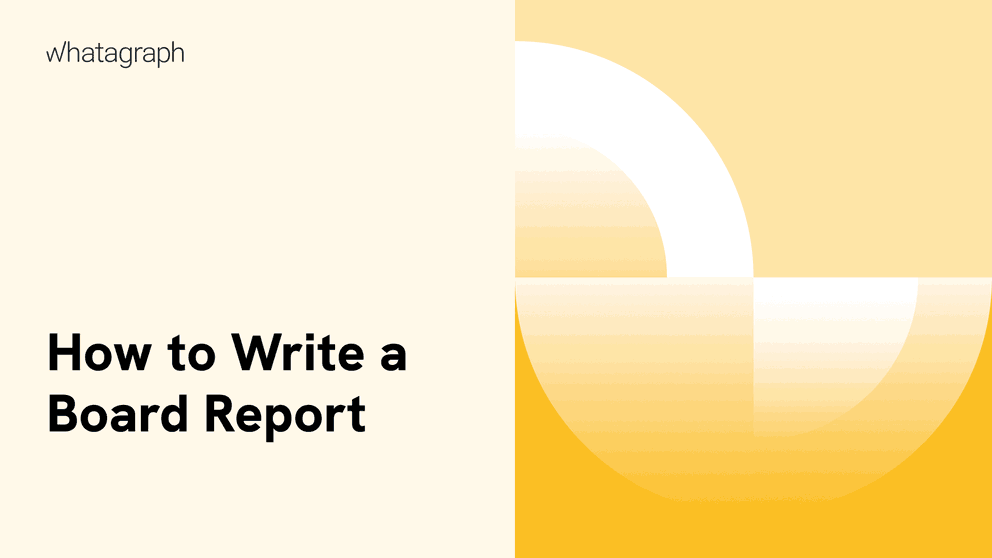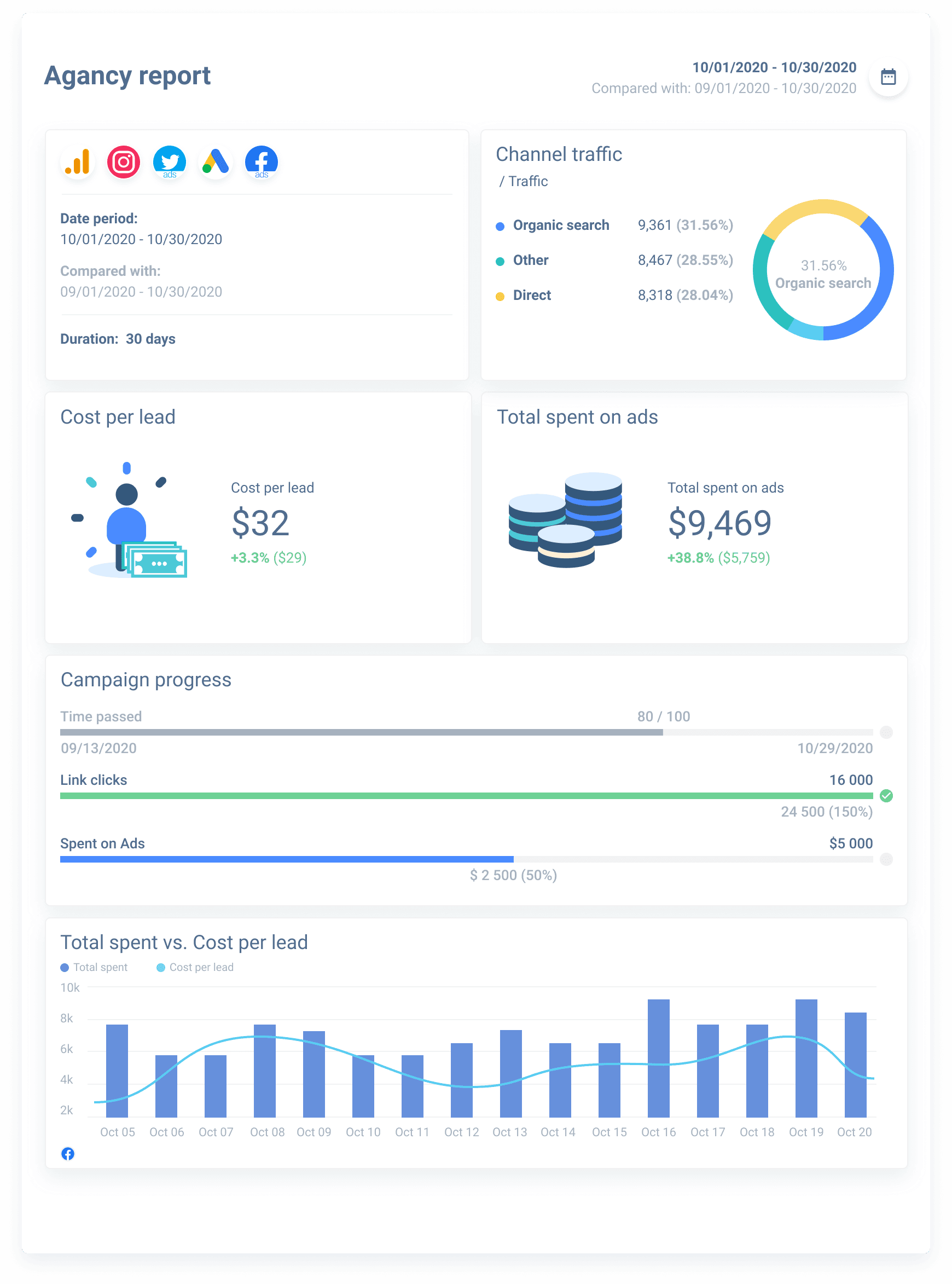What is a Board Report, and How to Write One?
Board meetings are an important event in any company. Many decisions are made regarding the organization. At the executive level, these decisions have to be based on good information. Yet very few people head to read board reports, making the entire meeting less productive and information less valuable. Not to mention the fact that even in nonprofits, business decisions could be made based on incomplete information.

Mar 29 2021●5 min read

Board reports are notoriously dull to read. The CEO usually prepares them to get board members up to date with the company's performance or specific issues on the board members' agenda. The format of the board report is usually dry and not very engaging.
It's not all doom and gloom. With Whatagraph, it's possible to bring life into the pages of board reports. A good template and informative writing will help convey crucial information in a board meeting app. Example below:

What is a board report?
In most basic terms, a formal board report is a piece of information from several different departments or committees condensed into a short and quickly readable format. These reports become a part of the board meeting minutes and are kept as records. These records can be called upon at any time, especially if legal issues arise. This is the key reason why board reports should be reviewed by every member of the board of directors and its details not be lost during the meeting.
Reports are usually prepared by the executive committees or the CEO of the company. The most important thing to remember is that the organization's executive branch must report to the board. Hence, they are the ones preparing the report.
What is the purpose of the board report?
The board report can serve a lot of different purposes. For example, it can be used for setting milestones in fundraising or financial statements. Whether a committee or the CEO prepares it, the format and the size can vary depending on the information the committee report must reflect.
Bringing board members up to speed
One of the purposes of a board report is to bring the new board up to speed with what the executive director or board committees have been doing. The period is usually set at the interval at which the board meeting is held. So, it could be quarterly, every six months, or even yearly. This report gives a chance for all board members to get in the loop and ask questions they had since the last board meeting. Every board member is expected to be an active participant in the organization.
Reminding board members of the commitments they made
If the board gives clear goals to the executive director or a committee, the CEO report must reflect the work that has been done. The board must also recognize the efforts their employees put in to reach these objectives, and the report is there to showcase their work.
Initiating discussions and raising questions
The chief executive director can open up the meeting, by establishing Robert's Rules of Order, introducing the board report and reading the meeting agenda. After highlighting the most important aspects, reviewing the management's performance by the key metrics, and drawing attention to glaring issues, the board members will be ready for a discussion. During this process, the board activity report will be a great document to fall back on when more information is needed or a quick summary of the situation.
What is the difference between the board, the committee, and the director's report?
To make the answer simple, here are the three facts you should keep in mind:
1. The board usually assigns the committee to do a specific task. They report on that task only, and their data becomes part of the board report template.
2. The executive director reports on the performance and processes of the entire company. His report contains data from every department and management team.
3. The board report takes all of the above. It condenses the information into a single document sent to the board and presented during the board meeting.
How do you write a board report?
1. Pay attention to clarity.
In other words, it should be easy to read. Bring the most important aspects of the organization's performance and issues to the very front. That is the segment of the formal report that gets read the most. Here's the information that you must include in a professional board report:
2. Tell board members what to look out for.
The board report is a joint effort of all committee members put together into a single document. The executive summary in bullet points should point out key aspects, like the marketing channel performance or the dip in sales and its reasoning.
3. Give some context.
Because board members don't usually operate day-to-day, they will need context to the decisions, financial information, or the state of the industry to accurately interpret the report’s takeaways.
4. Raise important questions.
Board governance isn't there to only make financial decisions. They are also experts in the industry or have other skills to help guide the company to success. List out questions board members should be aware of and could bring answers into the meeting.
5. Add visual touches.
If you are responsible for creating the final report, make sure every department or committee uses as many visual representations of data as possible. Taking a quick look at a graph or a pie chart will give instant insight into the situation rather than reading a whole paragraph on it. Data analytics are your friend, and tools like Whatagraph can help you make a great executive report template for the entire team. Once you set up the board report format, it’s easy to stick to it at the next board meeting.
6. Send the report early.
Two days before the meeting is not nearly enough time to familiarise with the company's operations and performance in detail. Give board members more time and let them download the report as early as two weeks in advance.
3 Things to Make Your Board Report Outstanding
It takes much work to write a good board report. You rely not just on your skills but also those of your team. To make it easier, here are a few more things to keep in mind or to include in your report:
1. Make a report template. Invest your time and effort into the template format you will use in all of the following board reports. It will save you in the long run.
2. Use data analytics. The easiest way to present an accurate picture is to use visual data. Try software tools like Whatagraph to bring your writing to life. Sample the tool for free and try out templates that work for you.
3. Send in a PDF. Even if your company makes you use Google Docs for everything, make sure you download the final document as a PDF. Send it over to every staff member with time to read into the report. PDF shows professionalism.
The most important aspect of writing the board report is to ask yourself: would you read it? If the answer is yes, you are on the right path.

WRITTEN BY
Mile ZivkovicMile is the ex-Head of Content at Whatagraph. A marketing heavy with almost a decade of SaaS industry experience, Mile has managed multiple content marketing teams without losing an ounce of his writing passion.